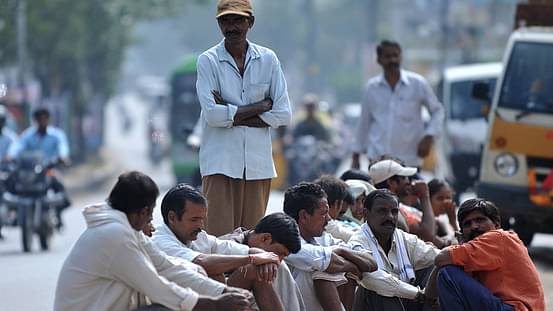Several hundreds of workers have packed their bags and are leaving from Delhi, Coimbatore, Mumbai, Pune, Surat, Kutch and Ahmedabad back to their villages in West Bengal, Bihar, Uttar Pradesh and Orissa as the current wave of the COVID-19 pandemic is wreaking havoc across the country. The fear of being stranded in the city struggling for food and without pay have driven many of them to bus stands and railway stations in these cities.
This year, unlike last year, transportation is available and none of the migrant workers want to be caught in a situation like last year where they are left without any resources. Their families want them back home. Almost all buses and trains to Bihar, Uttar Pradesh, Orissa, West Bengal and Jharkhand are running to capacity. From the Anand Vihar bust terminal at the Delhi-UP border, there are private buses running almost everyday ferrying people to Uttar Pradesh and Bihar.
Several of them are heading out from the border areas in Delhi because the government has enacted a night curfew and they fear that a full lockdown is imminent. In Maharashtra, though the government has stated explicitly that no lockdown would be imposed, and strict measures would be implemented, several workers feel that their employers may not pay them. In Surat and Ahmedabad in Gujarat, there is fear amongst the workers that they could die and their families back home would not even hear of it. Several of the construction and textile workers in Coimbatore and Tirupur went back because of elections, but they have not returned.
This migration comes amid rising Covid-19 cases across the country. In India, on Friday, April 16, 2.17 lakh cases were recorded in a single day and 1,185 new fatalities. The total number of cases has been recorded at 1,42,91,917 and the death count at 1,74,308. The number of the fatalities reported by the Union Health Ministry is widely disputed as it records the official figures released by states, but these numbers have been proven to be fudged in states such as Gujarat, Madhya Pradesh, Uttar Pradesh and Delhi.
Kaliya Singh, a factory worker in Kolhapur in Maharashtra, had arrived at Pune a day before to catch the train to Kharagpur in West Bengal. “There are thirteen other people with me. We are going back because we have no money. The factory has not paid us for the last 10 days. We cannot wait here believing that they will pay us. Last year’s experience has scared us. I don’t know when any of us will be back. Our families don’t want us to return to Maharashtra, but what will we do there also,” said a worried Singh.
This sentiment was shared by Sunil Yadav, who was waiting at Pune railway station to get on the train to Gorakhpur in Uttar Pradesh. “My train is at night. I work as a painter at a construction site, but now because of the lockdown I will not get any work. It is better for us to go back. At least I am with my family,” said Yadav. He was travelling with another nine people to Gorakhpur itself.
Mayur Kharat, who works with Pune Mahanagarpalika Kamgar Union, said that people had begun to leave a week ago. “At railway stations there are long queues. Several people don’t have tickets, but they will board the train if they can. Several of the workers are headed to Uttar Pradesh, West Bengal and Bihar. Many restaurant workers are also leaving. Several of their owners have also come to the station to try to dissuade them from leaving. Last year’s experience has left them bitter, and they are afraid of it repeating.”
The Maharashtra Chief Minister Uddhav Thackeray had announced a Rs 5,476 crore relief package with 3 kg of wheat and 2 kg of rice per person free of cost for one month to beneficiaries of the Food Security Scheme. “Shiv Bhojan Thali”, a meal scheme, will provide food free of cost to people for one month with a target of 2 lakh thalis in a month. Thackeray had announced Rs 1,500 will be given to 5 lakh licensed hawkers and 12 lakh auto rickshaw drivers and 12 lakh registered construction workers will get Rs 1,500 each in April.
But, none of this is enough. Bilal Khan of Ghar Bachao Ghar Banao Andolan, explains the statistics. His organisation works with those in the informal sector. He said, “The relief package will take care of probably 42-45 lakh workers across Maharashtra who are registered on the website. In Mumbai alone, there are at least 1 crore workers in the informal sector. In Mumbai there are 24 wards. For example, the M. East ward has a population of eight to nine lakh people, of which 90% of the economically weaker section live in slums. Calculate this across just Mumbai and see how the relief package falls short. The Shiv Bhojan Thali scheme is targeting only 2 lakh people. How can it be enough?” underscored Khan.
In Maharashtra, there are only 12 lakh construction workers who have registered on the website and that too recently. “Several of them are from Nagpur and most of those registered are BJP workers only. The population of those who need assistance runs in crores, that is why many are leaving. They are scared. The strict measures or the lockdown is classist and will not help the poorest. They are likely to die of hunger. In addition to this, slums are being demolished during this time. 250 families have been forcefully rendered homeless in Kandivali in north Mumbai.
The fear is palpable across the country. That is what has sent Rakesh’s uncle who was working at a construction site in Nangloi back home to Baraich in Uttar Pradesh. “He didn’t tell me when he was leaving. He had told us that he would be here for another week, but he got a bus ticket and left. My uncle left with six others,” said Rakesh.
It took Rakesh nine days last year to walk back home amidst one of the strictest Covid-19 lockdowns in the world imposed by the BJP-led Narendra Modi government. “Now, there is hardly anyone left in the area we are living. Even I will go soon. Last year was a lesson for me as we were left without food, transport or any support. Now when there is transport, I should go back. Already the Delhi government has imposed a weekend curfew, who knows what will happen next,” added Rakesh.
Anticipating a Covid-19 surge, the Uttar Pradesh government is setting up quarantine centres for the migrant workers to be tested. However, many of those returning are avoiding the Covid-19 testing. “A relative of mine died at a quarantine centre as there is no adequate care or food being provided. Why will I put my life on the line? I am leaving Delhi and going to Allahabad to ensure that I will go back to my family. I am not going back to stay at a quarantine centre. I will get off before my stop and figure a way to reach home. It is safer for me to reach home, at least my wife and parents are there,” said Raju, who was on his way from Najafgarh.
In Surat, there are close to 3 lakh migrant workers from Bihar of which 1.5 lakh workers have now set up their homes in the city. They work predominantly in the textile, diamond and construction business. “Almost all of the remaining 1.5 lakh workers had gone back last year in July-August and close to 1.25 lakh had returned towards the end of the year. Of these, almost 75,000 have left again. Everyone is afraid and worried because of what happened last year. Daily close to 2,500-3,000 workers leave from Surat to various parts in Bihar by buses or trains. The situation in Surat is worrisome and they do not want to die here,” said Dharmesh Singh, secretary of the Bihar Foundation in Surat. The migration hasn’t reached last year’s rate, he added as an afterthought.
In Gujarat, no announcements have been made on lockdown or a shutdown or on government resources available. This inaction and apathy have people worried and scared, prompting them to leave. In Ahmedabad, factories are working only on half capacity leaving many workers without enough salary for food or rent. Several factories are working at below capacity because many workers have already left.
In Tamil Nadu, the migrant population reside mostly in Tirupur, Coimbatore, Nammakal, Dindigul and Erode. While there is no exodus like last year from here, people have slowly begun to leave. “Most of the workers here in the textile and construction industry are from Assam, West Bengal and Odisha. Most of them came back only in October-November, but many have already left. Several went back to vote, but they have not returned. We have been monitoring the trains going to Patna, Bhubaneshwar and Kolkata. They are full,” said Prithiviraj Sinnathambi, who works with Community Awareness, Research and Education Trust (CARET) in Coimbatore. The organisation works with migrant workers in the unorganised sector.
In a survey done by the Working People's Charter- a national alliance of informal sector workers (WPC)- after the unplanned lockdown in 2020 due to the Covid-19 pandemic, it was found that the major reason motivating their decision to leave was the loss of income and cessation of work. Several were worried of falling ill and dying of Covid-19. Amongst the states with the largest number of respondents, UP and Odisha showed the maximum number of those workers who did not want to return, though they did not own land and had significantly much to lose.





























































































